Are you a Quiet Speculation member?
If not, now is a perfect time to join up! Our powerful tools, breaking-news analysis, and exclusive Discord channel will make sure you stay up to date and ahead of the curve.
Pro Tour Rivals of Ixalan, the first Modern PT in two years, is in the books! And I'm feeling kind of flat about the whole thing. This is probably because I didn't watch the live version. It's not the coverage team's fault. However, I have no interest in watching live drafts, and trying to watch Modern at 4AM is not optimal. So I've been watching the clipped matches instead and enjoying some very good Magic. And also some Lantern Control. Today I will be examining both the hype leading up to Bilbao and the event's results to see if anything applies to the overall metagame.
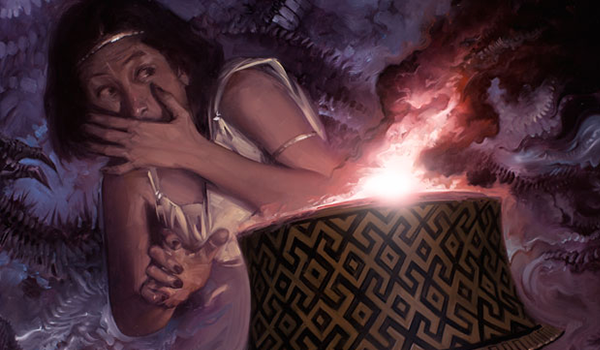
Lantern Control won the thing; well done, Luis Salvatto. However, it doesn't really mean anything. You can read whatever you want into the result, but the Top 8 of any Pro Tour is analytically meaningless. Unlike a Grand Prix, final standings tell us very little. Pro Tours are multi-format events, and their draft portion strongly influences standings. Andrea Mengucci went a mediocre 6-4 in Modern but still squeaked into the Top 8 thanks to his flawless drafting. Meanwhile, Alex Majlaton didn't make it despite an impressive 9-1 record in Modern. For that reason, I am ignoring the Top 8 for this analysis. Instead, I will focus on the decks that went 7-3 or better in Modern. This large dataset gives an accurate picture of the PT metagame. It will be interesting to see how it diverges from the actual metagame.
Pre-PT Fears
There's no getting around that the return of the Modern Pro Tour was controversial. There have been issues surrounding the tournament in the past, and many feared the consequences. 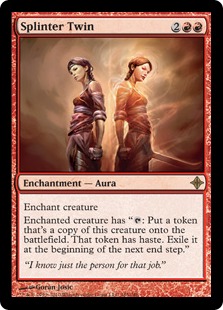 However, I didn't share the apprehension that many apparently felt about the return of the Modern Pro Tour. In fact I found it really surprising. There's always been this belief that Wizards banned cards before the Modern PTs to make them more interesting and shake up the format. And while it is slightly true, it's a dangerous oversimplification and is frankly a conspiracy theory.
However, I didn't share the apprehension that many apparently felt about the return of the Modern Pro Tour. In fact I found it really surprising. There's always been this belief that Wizards banned cards before the Modern PTs to make them more interesting and shake up the format. And while it is slightly true, it's a dangerous oversimplification and is frankly a conspiracy theory.
Forsythe flatly stated that the PT never forced bans, just their timing. And he unequivocally said that none would happen this time. Also, the idea that Wizards always bans the winning deck is ludicrous. And completely untrue. I'd love to see Ensnaring Bridge banned, but it's not going to happen. Every ban has been justified by something other than PT wins. Thus, the ban-related fear surrounding the PT's return just baffled me.
What didn't surprise me was the groaning from the Pros. For the most part, it was the usual moaning from the usual suspects. If you're unaware, Pro players generally don't like Modern because they're used to playing the best deck possible in Standard. The fact that such a deck 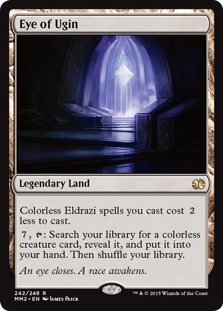 does not exist in Modern frustrates them, and their Standard skills don't always translate. This has a snowball effect because they never learn how Modern actually works, continue to have poor results, and get even more frustrated.
does not exist in Modern frustrates them, and their Standard skills don't always translate. This has a snowball effect because they never learn how Modern actually works, continue to have poor results, and get even more frustrated.
However, this time around, a new thread appeared. Apparently, Modern is too good for the Pros. The argument was that the Pros would find some monstrosity and completely ruin the best format in Magic. I actually laughed out loud it was so ridiculous. The idea that we enthusiasts needed to shield ourselves from the Pros is nuts on its face, but the arrogance on display was remarkable. History may have suggested otherwise, they were never going to break the format this time. While there are plenty of unique, interesting, and undiscovered decks lurking in subreddits and the MTGSalvation forums, there's a reason those threads go on for years without breakout success. Brewing in Modern is hard, and Pros don't dedicate the kind of time necessary to pull it off. Colorless Eldrazi was an exception, but every other deck that "broke" a big Modern tournament had been in the works for months. Considering how depowered Rivals of Ixalan is, the format was never going to break, and the results prove it.
The PT Top Tier
Pro Tours often have weird-looking metagames simply because they're exploring a new Standard. That is not the case this time, but it sill isn't a typical spread.
| Deck Name | Total # |
|---|---|
| Grixis Death's Shadow | 7 |
| Humans | 7 |
| Burn | 6 |
| Affinity | 5 |
| Mono-Green Tron | 4 |
| Mardu Pyromancer | 3 |
| UW Control | 3 |
| Eldrazi Tron | 3 |
| Abzan | 3 |
| Grixis Control | 3 |
| 4-Color Shadow | 2 |
| Lantern Control | 2 |
| UR Gifts Strom | 2 |
| BR Hollow One | 2 |
| Jeskai Control | 2 |
| Bogles | 1 |
| WB Eldrazi | 1 |
| UR Pyromancer | 1 |
| WB Zombies | 1 |
| Bant Knightfall | 1 |
| Madcap Moon | 1 |
| RG Eldrazi | 1 |
| Dredge | 1 |
| Jund Death's Shadow | 1 |
| Living End | 1 |
| Eggs | 1 |
| Titan Shift | 1 |
Linear Aggro and Grixis Death's Shadow were out in force for this tournament. I'll discuss my theory on why later, but we really didn't see anything new. Yes, even the supposed "breakout" decks were known quantities beforehand. So much for the Pros breaking the format.
 Despite Lantern's win, the story of the tournament is Gerry Thompson and his incredible run with Mardu Pyromancer. And fair enough, the Mardu devotees have suffered for so long it was time they got thrown a bone. However, don't get lost in the hype. The structural problems with the deck remain, particularly its slow clock. As I'll discuss shortly, the format was very favorable for such a removal-heavy deck to thrive. And it didn't really take advantage. In the wider metagame, I can't imagine that it doesn't still get eaten alive by Valakut and Tron or struggle against Rest in Peace.
Despite Lantern's win, the story of the tournament is Gerry Thompson and his incredible run with Mardu Pyromancer. And fair enough, the Mardu devotees have suffered for so long it was time they got thrown a bone. However, don't get lost in the hype. The structural problems with the deck remain, particularly its slow clock. As I'll discuss shortly, the format was very favorable for such a removal-heavy deck to thrive. And it didn't really take advantage. In the wider metagame, I can't imagine that it doesn't still get eaten alive by Valakut and Tron or struggle against Rest in Peace.
Oh, and there's also BR Hollow One. The fact that it made it in at all is surprising. Not an unwelcome surprise, mind you; the games were exciting to watch. However, the deck has a problem that will keep it from much mainstream success. I've played against the deck a lot in the past few months and it is actually weaponized variance.
Nobody knows what will happen when Burning Inquiry is cast. The caster may win on the spot, forcing their opponent to discard all their relevant cards or lands and dropping three Hollow Ones into play. Nothing could happen as both player discard irrelevant cards and there's no follow-up. Or you may screw yourself and discard all your threats. You never know. It's a gambler's deck, and if you're lucky, the pieces flawlessly fit together and you've got something broken. If not, it's an unplayable pile. Even when that doesn't happen, the deck can easily run out of relevant threats or gas. Treat it like Grishoalbrand: it's a high variance combo deck.
Day 2 Comparison
For once, Wizards is being generous with their data. We have the Day 2 conversion rate put together by Frank Karsten and the actual initial population of decks. What this clearly shows is that Humans was consistently on top of the metagame. This also means it has a poor 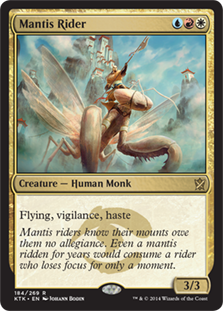 conversion rate to my table; 7/29 or 24% made it compared to 7/20 or 35% for Grixis. This doesn't mean anything—there were more decks that directly preyed on Humans than Grixis present.
conversion rate to my table; 7/29 or 24% made it compared to 7/20 or 35% for Grixis. This doesn't mean anything—there were more decks that directly preyed on Humans than Grixis present.
What is interesting is the top four decks from Day 1 were still the top three to convert to Day 2. The order for both days was Humans, Affinity, Burn, then Tron. This continues down the list as well. Grixis Death's Shadow was fifth; fell to sixth. Eldrazi was sixth; rose to Fifth. Jeskai control was seventh both days. Almost no movement in the chart indicates that one deck had a significant advantage over any other until after the second draft. Even then, the movement is small. My chart has Grixis instead of Tron in the top four, but Tron isn't far behind at fifth. Meanwhile, Jeskai fell precipitously to make way for Abzan Rock and Mardu Pyromancer to rise. Both these decks placed three pilots into my standings out of six Abzan pilots and seven Mardu. That's very good. It would suggest they were advantaged in some way, but we need to be careful. There's complications to these results.
Population Explanation
The easiest explanation for this metagame is population. The decks that did well in the constructed portion were highly represented in the overall population. The exceptions are Mardu Pyromancer and Abzan. This seems impressive, but remember that the pilots were Gerry Thompson and Reid Duke. Reid's a master of BGx and I can't imagine him not making it to Top 8, and Gerry's been tinkering with weird Modern decks for months. I expect he was more prepared than anyone else. As a result, the question is not why these decks performed well on the Pro Tour but why they were so well represented.
Comparison to the Real Metagame
Now, I direct your attention to the sidebar, which currently shows the December metagame statistics. If you're reading this after the next update comes out, the current order of Tier 1 is Grixis Shadow, Burn, Tron, Jeskai Tempo, RG Valakut, Eldrazi Tron, Affinity, Humans, Storm, and Counters Company. While this is similar to my table, there are a number of differences, and many "real" Tier 1 decks are not Pro Tour Tier 1. It is interesting that Grixis is on top of both my table (because alphabet) and our official rankings. However, Humans and Affinity are near the bottom, and the only Collected Company deck on my table is Bant  Knightfall. In fact, Company decks were barely present in Spain compared to reality. This looks like personal bias more than anything. Counters Company has some easy Oops, I Win games, but many are prolonged slogs through removal. Many may have not considered Company because of its complexity.
Knightfall. In fact, Company decks were barely present in Spain compared to reality. This looks like personal bias more than anything. Counters Company has some easy Oops, I Win games, but many are prolonged slogs through removal. Many may have not considered Company because of its complexity.
Valakut only posted one result on my table; Jeskai, two. This is not too surprising for Valakut, as like Counters Company, it was poorly represented. Jeskai is more of a mystery. If I had to guess, I'd say that lack of maindeck sweepers against all the Humans decks was the problem. UW is filled with sweepers and can more easily catch back up to a fast swarm. It's not a terrible matchup by any stretch for Jeskai, but I definitely feel behind when I'm playing Jeskai against Humans. Given how many were present, I imagine that caught up with Jeskai.
Why the Divergence?
Once the players start to filter back from Spain over the next week, I expect we'll learn the truth, but for now I can only speculate about why the Pros chose the decks they did. Many would have been like Seth Manfield, trying a number of decks but ultimately settling back into one they knew well. Or they were Reid Duke, and were never not going to play their deck. This is my explanation for Grixis Shadow, Tron, Affinity, and to some extent Abzan. However, I know that many teams meet the week before the PT to choose a team deck. I would bet that many actually set out to find a new deck and break Modern. And then failed. When they realized that wasn't going to happen, they had to find something else to run. Burn and Humans have reputations as easy decks to pilot (which isn't really true) and they gravitated towards them. Humans being a more disruptive deck would have made it more attractive. However, as I said, this is just speculation and we'll need to wait to hear from the players what really happened.
Does it Mean Anything?
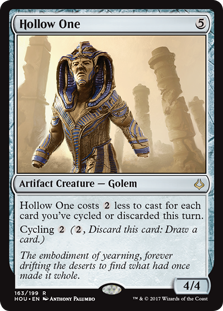 As an indicator of where the format is going, I believe the Pro Tour doesn't really mean anything. Weirdness surrounding how the event works and it being functionally an invitational tournament skews the hard data, and so I don't think there's much to learn about the wider metagame. However, that doesn't mean it won't have an effect. The event showcased some interesting decks from the fringe, and Lantern Control, and you'd better believe that your LGS will be swamped with Hollow One, Young Pyromancer, and Ensnaring Bridge soon. It never fails: players see something new, get excited, and buy up cards. Then, they turn around and play it to justify the investment. Be ready.
As an indicator of where the format is going, I believe the Pro Tour doesn't really mean anything. Weirdness surrounding how the event works and it being functionally an invitational tournament skews the hard data, and so I don't think there's much to learn about the wider metagame. However, that doesn't mean it won't have an effect. The event showcased some interesting decks from the fringe, and Lantern Control, and you'd better believe that your LGS will be swamped with Hollow One, Young Pyromancer, and Ensnaring Bridge soon. It never fails: players see something new, get excited, and buy up cards. Then, they turn around and play it to justify the investment. Be ready.
Going Forward
Despite everything, I'm glad that there was a Modern Pro Tour again. Let's face it: even when Standard was good, having only Standard Pro Tours was boring. The fact that Modern-skeptical Pros were forced out of their comfort zone was a bonus. From all appearances, Modern is too robust to be broken or solved, reaffirming the praise it has received for diversity and fun. I hope Wizards is finished forcing Standard and we continue to see Modern and team formats in the future.
Next week, I will either be reacting to the latest banlist update or finally getting around to Rivals of Ixalan in Modern. See you then!




yeah don’t run lantern even though it won, ignore what the pro players decided were the best modern decks to play against each other, stick to grixis shadow, storm, and tron. pro tours don’t mean anything…
In a way yes, PT doesn’t mean anything because the draft portion in swiss makes a huge impact and Ernenwein gave a good example of Andrea Mengucci going 6-4 in modern portion yet still making top 8 compared to other players that went better than that record in the modern portion but still did not make it to top 8.
Myself and others felt that the pt might be crushed by storm, tron, or lantern leading to a ban. I dont think it was a fear or a mania, just a plausible scenario. This didnt happen, so hooray.
Its a bit arrogant to say the pro tour results are meaningless. Yes its contextual – so is every event ever. You should always play the deck you think gives you the best chance to win – thats what the pros did. That doesnt mean everyone should buy and master lantern control since it won – it does mean that mardu pyromancer, ur pyromancer and) hollow one are better decks than most of us think, and that at a minimum they are good calls in certain types of metagames.
I also take issue with calling hollow one pure variance. This ignores the fact that burning inquiry and goblin lore are fuelling your adept, hollow one, and gurmag angler while possibly discarding looting, ghast, or phoenix for value. These are advantages that you get irrespective of the variance applied to the quality of your hand (which you correctly note is just as likely to be good or bad for your opponent) that your opponent does not. The deck is built to leverage these effects, not just playing them to roll the dice for a better hand or to mess up the opponent.
I agree with your statement that PT results aren’t meaningless. One could even argue that GP results are also meaningless considering that ANYONE who pays their 90$ entry fee can attend the main event. There are a lot of variables that come into play such a geographic limitations/local meta bias, as the article mentioned the way they structure the format where people can go 6-x and because they did well in sealed they can still go onto day two, and obviously the differences between MTGO and paper results. So are these PT results “meaningless”? No. Should they be taken with a grain of salt and still provide useful information? Yes.
I have to say that I disagree with some of the points being espoused here, in particular whether the decks that made it to the final are “real”. Mardu Pyromancer and Lantern have been putting up results for a long time now; the PT is just the last piece of validation that the decks are here to stay. The MTGO user under the name of selfeisek developed the first version of Mardu Pyromancer, and he lapped the field in the MTGO competitive league in terms of 5-0s, and it’s not like people don’t play Tron on MTGO; that matchup is indeed lousy, but it holds up well enough against the rest of the field to cement itself as a viable choice. And Lantern’s matchup profile has changed a lot since the adoption of Whir of Invention; you can’t really be favored against the likes of Burn without stretching the deck in all sorts of weird ways, but you can compete thanks to the suite of silver bullets, and that’s a big deal. Hollow One is indeed a bit of “chuck the dice and pray”, but one counterpoint is that the deck is built around most of the cards being discarded counting as a good outcome; the only ones you don’t really want to pitch are Gurmag Anglers and the Hollow Ones themselves. I think it’s pretty telling that it did well even in this relatively long slog of a Swiss (it’s more rounds than an SCG Classic, and we don’t dismiss those results).
It is the snobbery of this site that really gets me. This was supposed to be the go to site for everything modern, but every writer on here dismisses anything that isn’t affinity, storm, grixis shadow, or Tron. So all I see everytime I log in is how the new cool deck is actually trash and that I should just stick to established strategies. Not to mention all the modo video series you guys post are riddled with misplays, so they make the decks look worse. I’m not trying to be too critical here, but I feel like this site is trying to be the Salon of modern MTG news. I think we should all remember that Salon sucks…